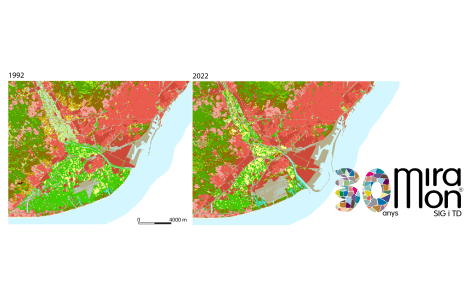Increased daytime temperatures is causing earlier leaf emergence

A study led by a CREAF-CSIC researcher has outlined a new methodology for describing changes in the life cycle of plants caused by planetary warmingwith higher precision. Daytime, rather than nocturnal temperatures determine phenological changes. The increase in temperatures, leading to an earlier spring, alters the global functioning of ecosystems.

A study published in the journal Nature Communications concludes that the increase of maximum as opposed to average daytime temperatures is what causes an earlier spring. Photosynthesis and the metabolism of plants are increased when temperatures rise, and increases in maximum temperatures is what most affects plant activity.
The researchers of the study used field measurements and satellite remote sensing data to show this relationship. The effort made it possible to develop a new conceptual framework that improves the prediction of changes in plant phenology provoked by climate change.
Using this new model it was confirmed that in Europe and the United States biological spring will start 4 to 5 days earlier than it did 30 years ago, above all being a response to maximum temperatures, not to averages or minimums.
Current models are only based on increases in mean temperatures and don't take into account other important variables in the life cycle of plants.
"Variation in maximum and minimum temperatures affect many biological processes related with phenology and should be taken into account in these models. In fact, beginning with the result of this study, now we will include maximum temperatures into the phenology models within global system function models," comments Josep Peñuelas, leader of the research team.
Changes in phenology could alter biogeochemical and biological cycles
Global warming and changes in phenology modify the carbon balance. On one hand, the increase of maximum temperatures accelerates the process of carbon fixation since diurnal temperatures stimulate theprocess of photosynthesis and leaf growth. On the other, the increase of minimum temperatures would hinder carbon absorption sincethe respiratory process of plants at night (without photosynthesis) would be accelerated and a large amount of the carbon absorbed would return to the atmosphere in the form of CO2.
Biological cycles of organisms are also sensitive to changes in phenology being caused by increased temperatures. "For example, if spring phenology is advanced unequally for different organisms, the lack of synchronization could lead to repercussions for the many interactions with exist between ecosystems'organisms, for instance between the plant and herbivore, plant and pollinator, herbivore and carnivore...and this could also change the compositions of communities of living organisms to a significant degree," says Josep Peñuelas.
Article:
Piao, S., Tan, J., Chen, A., Fu, Y. H., Ciais, P., Liu, Q., … & Peñuelas, J. (2015). Leaf onset in the northern hemisphere triggered by daytime temperature. Nature Communications, 6.
Autora: Marina Torres Gibert
Notícies relacionades

L’IPBES publica dos informes per transformar la manera com ens relacionem amb la natura, conservar-la i sobreviure

L’impacte social de la recerca es consolida a la cultura científica del CREAF


